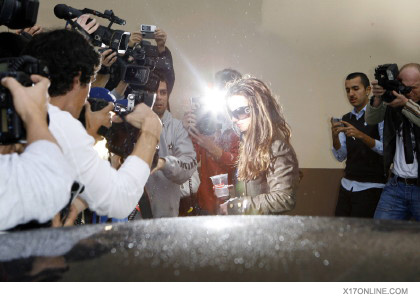Atlantic Monthly Contributors's Blog, page 122
July 13, 2016
A Clue in the Mystery of Van Gogh's Ear

NEWS BRIEF The story of how Vincent Van Gogh sliced off his ear has always held more than a few mysteries. It was 1888, and he had moved to Arles, France, to start a collective for artists. Paul Gauguin had joined Van Gogh there, and one night in December the two argued––though about what is a mystery. Van Gogh held a razor, and he possibly attacked Gauguin (or perhaps Gauguin attacked him) then in a fit of anger, depression, or hallucination, Van Gogh lopped off part of his ear, wrapped it in cloth, then handed it to a prostitute at a brothel. Among all the unknowns of this story, and Van Gogh’s life, is just how much of his ear he lost that night.
It was long believed Van Gogh cut off the bottom part, just the lobe. This Friday, a new exhibition at the Van Gogh Museum in the Netherlands features a drawing made in 1930 by a doctor who treated the artist. That drawing suggests Van Gogh sliced off nearly his whole ear.
The exhibition is called “On the Verge of Insanity,” and it follows the Dutch painter’s collapse into mental illness, the story of his mutilated ear, and his eventual suicide. One of the exhibit’s most hyped pieces is the drawing by Felix Rey, the young French doctor, which, as the Associated Press tweeted, looked like this:
Sketch by a junior provincial doctor offers evidence that painter Vincent Van Gogh cut off nearly all his ear. https://t.co/NSadEVbiW0
— The Associated Press (@AP) July 13, 2016
According to Rey’s drawing, all that remained of Van Gogh’s ear seemed to be a tiny flap of lobe––quite the opposite of what everyone has thought. Two people deserve credit for its discovery. One was Irving Stone, an author, who asked Rey to draw him the picture during his research for a book on Van Gogh’s life. The other person who deserves credit is writer Bernadette Murphy, who rediscovered it in Stone’s archive at the University of California, Berkley’s library.
For those obsessed with Van Gogh, or just morbidly curious, another item featured at the exhibit is a 7mm pocket revolver. It is quite possibly the same one the artist used to shoot himself in the chest in 1890 in the village of Auvers-sur-Oise. It took him two days to die. The weapon was found near the spot in 1960.

Jennifer Aniston Body-Shames the Tabloids

The tabloids are looking, honestly, a little bloated. Perhaps they’re pregnant? Finally? Can’t you see, if you look really closely, a little baby bump? Or, hmm, maybe they’ve just let themselves go a little? Maybe they’re depressed? Or maybe they’re not depressed enough? Or maybe they’re just aging out of relevance?
Related Story

Celebrity journalism in general, and tabloid journalism in particular, have long involved a Faustian bargain: We, the public, put up with the gossip rags’ assorted nonsense—the “bikini body,” the “baby bump,” the “post-baby body,” and all that—because we crave the pictures and the stories they deliver. A culture that treats fame as simultaneous cost and benefit comes with a corollary that is as pernicious as it is paradoxical: We assume that celebrities are better than us, but also that they belong to us.
No one has been a better, and also more unfortunate, symbol of all that than Jennifer Aniston—she of The Rachel and then of Brad-and-Jen and then of #teamjen and then of Office Space and lately of Horrible Bosses 2 and also of Aveeno and L’Oreal and Living Proof and Glaceau SmartWater. Jen (we can call her Jen at this point; she’s been a part of our lives for so long) is favored fodder for paparazzi and the “journalistic” outlets they serve. Her movements are obsessively followed; her relationship status (is it a ring, or Engagement Bling?) is the subject of ongoing speculation; her uterus (“baby bump?”/“baby bump!”) is the subject of intense scrutiny. And she has, at this point, had enough of it. Which is why, this week, Jen took to the pages of The Huffington Post to excoriate the paparazzi for their treatment of her:
The way I am portrayed by the media is simply a reflection of how we see and portray women in general, measured against some warped standard of beauty. Sometimes cultural standards just need a different perspective so we can see them for what they really are — a collective acceptance... a subconscious agreement. We are in charge of our agreement. Little girls everywhere are absorbing our agreement, passive or otherwise. And it begins early. The message that girls are not pretty unless they’re incredibly thin, that they’re not worthy of our attention unless they look like a supermodel or an actress on the cover of a magazine is something we’re all willingly buying into. This conditioning is something girls then carry into womanhood. We use celebrity “news” to perpetuate this dehumanizing view of females, focused solely on one’s physical appearance, which tabloids turn into a sporting event of speculation. Is she pregnant? Is she eating too much? Has she let herself go? Is her marriage on the rocks because the camera detects some physical “imperfection”?
This is really good, and really important, stuff. The whole post, tellingly titled “For the Record,” is well worth reading. And that’s particularly so because Jen emphasizes the fact that the paparazzi’s treatment of her is simply an extreme extension of how the culture at large has been treating the women who are both part of, and subject to, its whims. Despite all the progress feminism has made in the past decades, we still live in an age that treats women’s bodies as objects of communal ownership. An age that effectively regards women not just as people, but also as vessels—waiting to be filled and made complete by way of partners and children and families.
Despite all the progress feminism has made in the past decades, the culture at large still treats women’s bodies as objects of communal ownership.
At its extremes, it’s a toxic assumption. It’s the kind of regressive thinking that underscores rape culture and that challenges women’s reproductive rights and that, in general, allows individual women to be seen as less than. Jen is both good and entirely right to point that out. She is also right, although perhaps hopelessly naive, to want us all to adapt our vision for a more egalitarian world: to see individual women as full and complete unto themselves, regardless of their relationship status or whether they choose, or choose not, to have kids.
It’s difficult, though, to overlook the irony inherent in Jen’s accusations of tabloids’ role in perpetuating those assumptions. Jen may resent the tabloids; this is both despite and because of the fact that she relies on them for part of her livelihood. The photos of her that end up in People and US Weekly and The Daily Mail and TMZ and the like help stoke public interest in her, and by default, her movies. And Jen’s omnipresence in the lower orders of celebrity journalism raises her social capital, which in turn makes her appealing to the corporations that sell Aveeno and L’Oreal and Living Proof and SmartWater—brands that exploit not just Jen’s literal image, but also her figurative one. Brands that buy, with every endorsement contract, Jen’s glossy hair and glowing skin and also her wholesomeness and her health and her status as The Girl Next Door who is now, at 47, a Woman.
Media theorists talk about “ambient awareness,” the phenomenon by which one becomes constantly aware of the doings of friends and colleagues through those people’s updates on Facebook and Twitter and Snapchat and the like. Ambient awareness is commonly understood as a byproduct of the Internet age; in its basic impulses, however, it is something the tabloids have long exploited. Mags and rags and Entertainment Tonight-esque TV shows have, for decades, kept celebrities constantly around, whether they’re frolicking on a beach or attending a movie premiere or being, you know, Just Like Us. Celebrity journalism, in almost all its forms, has taken a fairly literal interpretation of the “star”: a heavenly body that might not always be seen, but that is always there—shining and glowing and, in pretty much every sense, above the rest of us.
Jen’s brand itself endorses, however much she might not want it to, the relationship-obsessed tropes of the tabloids.
Jen has profited, financially and otherwise, from those dynamics of celebrity telepresence. She is not just a person, but a brand—one that is both transcendent and omnipresent, one that can be bought and sold along with Aveeno lotion and Living Proof shampoo and bottles of questionably intelligent SmartWater. Her brand has to do with Jen as simultaneously a physical object and a human narrative: the jilted wife, the hopeful single girl, the maybe-mom.
Which is also to say that Jen’s brand itself endorses, however much she might not want it to, the relationship-obsessed tropes of the tabloids. Every maybe-baby-bump speculation TMZ shares with its craven/craving audience helps her to sell things. “Herself” being one of those things.
That’s not to say that “For the Record” is invalid. Jen’s argument, on the contrary, is extremely true: Tabloids have become more invasive in recent years. And their encroachment may be—just like the fact that you know your best friend from first grade just had a baby even though you haven’t talked to her in five years—a byproduct of the Internet age.
But perhaps the takeaway here is about more than sexism in celebrity journalism. Perhaps it is also about the technological structures underpinning celebrity journalism. Celebrities now have more say over their own brands via the messages they put forward in their Facebook and Instagram and Twitter and Snapchat feeds; paparazzi, as a result, now distinguish themselves by seeking, in particular, the images and the stories that celebrities don’t see fit to share themselves. Which often means post-gym pictures and makeup-free pictures and, yes, speculative-baby-bump pictures. Jen published her essay on The Huffington Post because, as she noted, she is “not on social media”; perhaps she feels particularly helpless within that shifting landscape because she has even less recourse than, say, Beyonce or Taylor or Kim to fight back against all that. Her fellow lady-celebs have massive—and tabloid-corrective—social media followings; now Jen has The Huffington Post.

The Russian 'Traitors' Competing in the Olympics

NEWS BRIEF All of Russia’s track-and-field team will sit out next month’s Rio Olympics because of the widespread and system-wide doping that was recently uncovered—except for two who won’t compete under the Russian flag. The first to announce she would attend Rio as a neutral athlete was 800-meter sprinter Yuliya Stepanova, whom the International Association of Athletics Federations (IAAF) cleared earlier this month.
A few days ago, the IAAF announced it would also allow Russian long-jumper Darya Klishina to compete as a neutral athlete. And just like Stepnova, Klishina has come under massive criticism. A popular journalist compared her to the Russians who helped Nazis in World War II. Some critics called her a “traitor and scum.” The Moscow-based newspaper Argumenty I Fakty pulled some of these excoriations together from social media:
"It seems that the jumper jumped so well that she jumped out of the country ... the fans in Russia will not be with you, " - opined Nikolai Ivanov .
"You have decided to act under a neutral flag? For you, this is not humiliating? Can you really change nationality, " - says Igor Kljukvin .
The duo weren’t the only Russian athletes to apply for neutral status. More than 130 track-and-field competitors applied to compete under no nation’s flag, saying they weren’t involved in the doping scandal. Of those, the IAAF has denied 67 requests, and approved two: Stepanova and Klishina’s. The rest are still up for review.
Stepanova was allowed to compete as a neutral athlete because she helped uncover the scandal in 2014 that brought about the ban on Russian track-and-field athletes. For that, Russian President Vladamir Putin called her “Judas.” The IAAF said it allowed Klishina to compete, because she met the “exceptional eligibility criteria.” Although it did not say specifically why it approved Klishina’s request, the IAAF said it looked at whether the athletes were tainted by the Russian Athletic Federation’s “failure to put in place adequate anti-doping systems because they have been subject to other, fully adequate systems outside of the country for a sufficiently long period … ”
And indeed, Klishina has lived in the U.S. for three years.

Escape by Olive Oil

NEWS BRIEF The FBI issued an arrest warrant for polygamist leader Lyle Jeffs Wednesday after he escaped house arrest by slipping out of his GPS tracking bracelet using a common kitchen staple: olive oil.
Salt Lake City’s Fox 13 has more:
"He used a substance which may have been olive oil to lubricate the GPS tracking band and slip it off his ankle," Eric Barnhart, the Special Agent-in-Charge of the Salt Lake City field office of the FBI, said in an interview with FOX 13. "The damage to the bracelet was not such to trigger the full array of alarms that law enforcement or the U.S. Marshal's Service would have responded to."
Jeffs, the leader until 2012 of the Fundamentalist Church of Jesus Christ of Latter Day Saints Church (FLDS), was awaiting trial on charges of food-stamp fraud—charges his attorneys want dropped.
The FLDS is a polygamist off-shoot of the Church of Jesus Christ of Latter Day Saints. The FLDS came under national scrutiny in 2011 after Jeffs’ brother and then-church leader Warren Jeffs was found guilty of child rape and sentenced to life in prison.

Tom Brady's Upheld 'Deflategate' Suspension

NEWS BRIEF Tom Brady likely will not play in the first four games of the upcoming NFL season.
The 2nd U.S. Circuit Court of Appeals denied the New England Patriots quarterback’s appeal Wednesday to get a new hearing regarding his “Deflategate” suspension. As ESPN explains:
The court had upheld Brady's suspension in a 2-1 decision April 25, deciding that commissioner Roger Goodell's discipline was properly grounded in the collective bargaining agreement and that Brady was treated fairly.
Brady appealed en banc, asking the entire panel of the 2nd U.S. Circuit Court of Appeals to participate in the hearing. Seven of the 13 judges would have had to agree to an en banc session before a hearing was held.
While Brady could still appeal his case to the U.S. Supreme Court, it looks as if his suspension will stick, ending a long chapter in the cheating scandal from early 2015. It was then the NFL alleged Brady was “at least generally aware” footballs were underinflated in the AFC Championship against the Indianapolis Colts, giving the Patriots an advantage. The Patriots beat the Colts 45-7 in that game, advancing to the Super Bowl.
Unless the league changes its decision or Brady appeals to the Supreme Court, he will miss the first four games of the regular season against the Arizona Cardinals, Miami Dolphins, Houston Texans, and Buffalo Bills, and his legacy as one of the great quarterbacks of this generation will be tarnished. Backup quarterback Jimmy Garoppolo will start in Brady’s stead.

The 'O Canada' Lone-Wolf Controversy

A Canadian quartet has become a trio—at least for now. At the All-Star Game on Tuesday, The Tenors, the platinum-album selling, British Columbia-based quartet, sang an altered version of “O Canada,” which swapped in words that referenced “All Lives Matter.”
The switch came during the middle part of the anthem, normally sung in French. The original lyrics go:
“With glowing hearts we see thee rise. The True North strong and free.”
But Tuesday it went:
“We’re all brothers and sisters. All lives matter to the great.”
The modified lyrics were sung by quartet member Remigio Pereira; the other three members wordlessly harmonized. The alteration and slight to the Black Lives Matter movement passed largely unnoticed to the crowd at Petco Park. But Pereira also held a paper-sized sign with “All Lives Matter” written on its back that shocked the American crowd when it appeared on the scoreboard’s screen. The other members of the quartet called Pereira’s act that of a “lone wolf.” On the group’s Twitter, they posted an apology:
— The Tenors (@TenorsMusic) July 13, 2016
The anthem was not broadcast in the U.S. But it was in Canada, and people on social media criticized the group.
Canada fact: The Tenors used to be called The Canadian Tenors but they aren't anymore, and good call, because they do NOT speak for us
— Harrison Mooney (@HarrisonMooney) July 13, 2016
Memo to MLB: if you're looking to attract black fans and players, All Lives Mattering the anthem -- even O Canada -- ain't the way to do it.
— Morgan Campbell (@MorganPCampbell) July 13, 2016
The Tenors formed in 2007, and have played more than 150 television spots, the 2010 Olympics, and alongside Elton John, Sting, and Neil Young. And while the other band members quickly denounced Pereira’s actions, Pereira defended himself on Twitter, where he called himself a spokesman for the “human race and the lives of all sentient beings.” Pereira does not shy away from personal opinion. On his Instagram he regularly he defends the theory of a flat Earth.
A photo posted by Remigio Pereira (@remigiosmusic) on May 13, 2016 at 2:57am PDT
The debate over the terminology on whose lives matter is controversial. Those who support the term “All Lives Matter” say they believe it represents everyone. But defenders of Black Lives Matter say “All Lives Matter” misses their point—that they are often unfairly—and disproportionately—targeted by law-enforcement authorities around the country. President Obama has explained the difference: “I think the reason that the organizers used the phrase ‘black lives matter’ was not because they were suggesting nobody else’s lives matter. There is a specific problem that is happening in the African-American community that’s not happening in other communities,” he said. “And that is a legitimate issue that we’ve got to address.”

In With the New at the 2016 MLB All-Star Game

Since 2003, when it was first used to decide home-field advantage in the World Series, the Major League Baseball All-Star Game has played out at a tricky intersection of new incentive and old custom. Holding to tradition, the game still features at least one player from each team, and the managers leading the American League and National League representatives still do their best, within reason, to let most of those players see the field. Because a win ensures a postseason advantage, though, propriety sometimes gives way to strategic practicality. Even as the best players exit the game, swapped out for their backups in an effort to let fans get a more complete view of the assembled talent, the moment-by-moment decisions get more cutthroat, less charitable.
In any one installment of such a strange institution, it can be hard to find a binding narrative, but over the last few years of All-Star games, a pattern has emerged. In 2013, the New York Yankees’ closer Mariano Rivera, who had announced that he would retire at the end of that season, was the subject of much fanfare and became the unofficial honoree of the game. In 2014, the Yankees’ famed shortstop Derek Jeter, having announced his own impending departure, received similar treatment. Prior to this season, the Boston Red Sox slugger David Ortiz said he would call it quits at the end of the year; Tuesday night’s game in San Diego was all about the man affectionately known as Big Papi.
While those icons have said their goodbyes, another trend has unfolded in recent All-Star games. On the whole, the sport has started skewing younger. Over a decade or so spanning the ’90s and 2000s, baseball seemed the fiefdom of entrenched and immovable stars—Roger Clemens, Alex Rodriguez, Albert Pujols, Jeter, Ortiz—but it now rides an invigorating and apparently inexhaustible wave of fresh talent. If the midsummer classic makes for a clumsy game, then, it also offers a snapshot of a sport in flux, and of the possibilities and challenges therein.
Ortiz, the American League’s designated hitter, didn’t do much on the field of play Tuesday night, flying out and walking in his two at-bats before getting lifted for a pinch runner and receiving handshakes and hugs from each of his teammates on his way back to the dugout. That bit of ceremony aside, the real action was dominated by the youngsters. Wherever you looked, some upstart did something astonishing, and the announcers made sure to pin his age to their description of whatever had just happened. The Chicago Cubs’ Kris Bryant, 24, hit the game’s first home run in the opening inning, lifting a fly ball deep to left field, and the Kansas City Royals’ Eric Hosmer and Salvador Perez, each 26, doubled his feat in the next frame. The only runs to be driven in after the first two innings, in what would end up a 4-2 American League win, came off the bats of Hosmer and Marcell Ozuna, the Miami Marlins’ 25-year-old outfielder.

The American League catcher Salvador Perez (13) of the Kansas City Royals hits a two-run home run in the second inning in the 2016 MLB All Star Game at Petco Park. Jake Roth / USA TODAY Sports / Reuters
Indeed, the centrality of youth to the game was evident even before the first pitch. FOX’s graphics delighted in framing and reframing the figures. The American League’s starting infield featured not a single player older than 26; the National League’s outfield had a 23- and 25-year-old. Bryce Harper and Mike Trout, two of baseball’s biggest stars appearing in their fourth and fifth All-Star games, don’t have 50 years between them. A whopping 34 of this year’s All-Stars were first-timers, and 27 players on both rosters were age 26 or younger.
On the field, the younger participants seemed to give the game more of a charge than it’s sometimes had in the past. Pitchers threw their hardest in limited duty; the Miami Marlins’ Jose Fernandez and Yankees’ Dellin Betances, especially, delighted with triple-digit fastballs and dizzying curves. Infielders performed all sorts of quick-handed trickery, and batters looked to be in constant pursuit of the long ball. For the casual fan, the athleticism on display was a handy summary of the style this new generation of players has brought to baseball. The game might be a little more slender now than it was a few years ago, in that age of muscled-up thirtysomethings, but it’s more than a little quicker.

The American League pitcher Dellin Betances (68) of the New York Yankees throws a pitch in the seventh inning in the 2016 MLB All Star Game at Petco Park. Mandatory Credit: Gary A. Vasquez / USA TODAY Sports / Reuters
The shift is not wholly positive, though, at least from the perspective of those in charge of marketing the sport. Major League Baseball did not honor Ortiz on Tuesday only out of benevolence; he remains, in his final campaign, more recognizable than almost all of the other players present in San Diego. This is just the latest installment of a troubling PR pattern. Retired greats like Jeter, aging players like Ortiz, and even mostly washed-up ex-stars like Pujols and Rodriguez seem to retain their notoriety at the expense of their younger cohorts. At a time when World Series viewership trends downward, this suggests that baseball is increasingly thought of as a sport of history, with the dominant NFL and the charging, star-laden NBA replacing it as today’s entertainments of choice. One wonders if baseball’s penchant for bronzing its own past has contributed to effect, if the annual send-offs have gotten in the way of some much-needed introductions.
Baseball may soon be broken of this habit, without much say in the matter. There’s no obvious candidate to inherit the Rivera-Jeter-Ortiz role of elder statesman at the 2017 All-Star Game in Miami, no sunset-riding hero from one of MLB’s storied franchises to act as honoree. If this might rob the event of a now-familiar unifying element, though, it should also make complete a process that’s been going on for some time. Major League Baseball, for better or worse, now belongs to the kids, and the sport’s powers that be will have to set aside the sepia tones, let their thrilling play stand on its own, and hope that it’s enough to get people to watch even if the old familiar faces are all gone.

July 12, 2016
Justice Ginsburg's Mistake

2016 is not a great year for judicial independence and the norms on which it rests. First, Senate Republicans refused to even consider President Obama’s nominee for a vacancy on the U.S. Supreme Court, arguing the next president should choose Justice Antonin Scalia’s replacement. Then Donald Trump, their party’s likely choice to be the next president, made a series of racist attacks last month against federal judge Gonzalo Curiel, who is overseeing two of the Trump University lawsuits.
Compared to those maneuvers, Justice Ruth Bader Ginsburg’s critiques of Trump over the past few days seem tame. But they are extraordinary nonetheless. In an AP interview on Thursday, Ginsburg said there could be more vacancies on the Court in the near future. "It's likely that the next president, whoever she will be, will have a few appointments to make," Ginsburg said, an apparent reference at presumptive Democratic nominee Hillary Clinton.
Had Ginsburg stopped there, her comment could’ve been seen as a harmless tongue-in-cheek quip. But when asked about a possible Trump victory, she made her views even more explicit. "I don't want to think about that possibility, but if it should be, then everything is up for grabs,” Ginsburg said. She then expanded her criticisms in a series of interviews on Monday and Tuesday.
“I can't imagine what this place would be—I can't imagine what the country would be—with Donald Trump as our president," she first told the New York Times. “For the country, it could be four years. For the court, it could be — I don’t even want to contemplate that.” In apparent jest, Ginsburg also briefly alluded to moving to New Zealand.
“He is a faker,” she then said in a previously scheduled interview with CNN journalist and Supreme Court biographer Joan Biskupic. “He has no consistency about him. He says whatever comes into his head at the moment. He really has an ego. … How has he gotten away with not turning over his tax returns? The press seems to be very gentle with him on that.”
Trump fired back in comments to the Times:
“I think it’s highly inappropriate that a United States Supreme Court judge gets involved in a political campaign, frankly,” Mr. Trump said. “I think it’s a disgrace to the court and I think she should apologize to the court. I couldn’t believe it when I saw it.”
He continued: “That she should be saying that? It’s so beneath the court for her to be making statements like that. It only energizes my base even more. And I would hope that she would get off the court as soon as possible.”
The content of Ginsburg’s remarks isn’t particularly explosive. Nor is her disdain for Trump surprising. In many ways, he represents the antithesis of her career. He’s made decades of antiquated comments about women and briefly suggested they should face “some form of punishment” for having abortions. (He quickly recanted that comment, although his views on reproductive rights are far from clear.) By contrast, Ginsburg’s lifelong work on gender equality and women’s rights made her a feminist cultural icon.
But it’s still stunning that Ginsburg would publicly criticize a presidential candidate during an election campaign. The Constitution grants her and her colleagues lifetime tenure precisely to insulate them from these forces. While the current justices are far from cloistered monastics—nor should they be—they still avoid commenting on electoral politics or specific candidates. If another Supreme Court justice has publicly criticized a political candidate during an election in the past century, I’m not aware of it.
How serious a breach of judicial norms did Justice Ginsburg commit, if any? Bloomberg’s Noah Feldman noted the Constitution doesn’t require justices to be nonpartisan. Even John Marshall, the father of American constitutional law, served as both chief justice and John Adams’s secretary of state at the same time, he pointed out. “As a lawyer and as a citizen, I’d always rather know what justices and judges think rather than have enforced silence and pretend they have no views,” UC Irvine law professor Erwin Chemerinsky added.
Others are less forgiving. In assessing Ginsburg’s remarks alongside declining trust in American institutions, the Washington Post’s Dan Drezner said if Ginsburg does not apologize for her remarks, she “bears almost as much responsibility as Trump for the slow-motion crisis in American democracy.”
That’s a stretch, to say the least. Trump frequently expresses contempt for basic norms of American democracy, including pluralism and the rule of law. Ginsburg does not. Nor is Ginsburg bound by the federal judges’ code of ethics, as Drezner suggested, which forbids them from supporting or opposing candidates. Chief Justice John Roberts wrote in 2011 that he and the other justices “follow the same general principles respecting recusal as other federal judges, but the application of those principles can differ due to the unique circumstances of the Supreme Court.”
That said, it’s hard to imagine how Ginsburg could justify not recusing herself if the election comes down to a Bush v. Gore-type case. She wouldn’t be the first justice to face ethics questions during an election dispute. Justice Sandra Day O’Connor reportedly said during an election-night dinner party in 2000 that she and her husband would have to wait longer to retire after the networks called Florida for Al Gore. A few weeks later, she cast a fifth vote to end the Florida recounts, effectively deciding the election in George W. Bush’s favor.
Ginsburg’s close friend Antonin Scalia also received intense public criticism for his involvement with the political branches. In 2004, Scalia refused to recuse himself from a case involving Vice President Dick Cheney, with whom he had recently gone on a hunting trip. The Sierra Club’s motion for him to step aside led Scalia to publish an unusual 21-page memo defending his decision. “If it is reasonable to think a Supreme Court justice can be bought so cheap, the nation is in deeper trouble than I had imagined,” he wrote.
Scalia later referred to the memo as his “most heroic opinion—maybe the only heroic opinion I ever issued.” While he eventually sided with Cheney in the case, his vote in the 7-2 decision wasn’t decisive on the outcome.
The lessened standards for justices are largely pragmatic. When lower-court judges recuse themselves, another judge can simply take their place. No mechanism exists for the nine justices on the Supreme Court to do the same. “Even one unnecessary recusal impairs the functioning of the Court,” the justices wrote in a 1993 statement on recusal policy. A series of 4-4 splits in major cases last term after Justice Antonin Scalia’s sudden death shows the limits of an eight-justice court.
That singular role in American society also underscores why Ginsburg’s comments were a mistake. She and her colleagues are not ordinary judges. In the right circumstances, they can reshape vast sections of American society for better or worse. It is also a final bulwark against the violation of constitutional rights. But, as a Founding Father once noted, the justices have “neither force nor will, only judgment.” It falls to Congress and the president to obey and enforce those rulings.
By January, both of those branches could be in control of Trump and his political party. And now, in any hypothetical 5-4 decision in which Ginsburg sides against a Trump administration, he and his cohorts now have evidence of bad faith from the court that keeps them in check. For a president who has already shown little interest in judicial and democratic norms, that’s a dangerous weapon to place in his hands.

D.B. Cooper's Final Escape

Well, D.B. Cooper, if you’re out there—and if that really is your name—it looks like you’ve gotten away with it.
Cooper, or a man calling himself that, jumped out of Northwest Orient Airlines flight 305 and into American criminal mythology on November 24, 1971. He board the plane in Portland, Oregon, ordered a bourbon and soda, and began smoking filtered Raleigh cigarettes.
A little bit after takeoff, Cooper handed the stewardess (it was the ’70s) a note saying he had a bomb and asking her to sit next to him. He flashed a briefcase full of wires and demanded $200,000 and four parachutes. She took the note to the pilot. The plane landed in Seattle, where Cooper let the passengers off and took the cash and the chutes. Then he and a few crew members took off again, bound for Mexico City, as he demanded. Somewhere between Seattle and Reno, Cooper jumped out of the plane. He was never heard from again.
On Tuesday—44 years, 7 months, and 18 days after the hijacking—the FBI announced it is closing the Cooper file for want of evidence. Or in the dry language of law enforcement, “The FBI has redirected resources allocated to the D.B. Cooper case to focus on other investigative priorities.” Over the years, agents had considered 800 suspects and whittled down the list to less than two dozen. Not that they’re giving up entirely. “Although the FBI will no longer actively investigate this case, should specific physical evidence emerge—related specifically to the parachutes or the money taken by the hijacker—individuals with those materials are asked to contact their local FBI field office,” the agency said in a statement.
It has long seemed likely that Cooper’s mystery would remain just that, but the FBI’s announcement marks a more formal surrender. The story was all the more alluring for the tantalizing clues that have emerged over the years. No one even knows for sure who “Cooper” was. He bought his plane ticket as “Dan Cooper,” but who he really was and or what he was really named remain subject to intense speculation but unknown. (He became popularly known as “D.B.” after the FBI interviewed, and then cleared, a Portland-area reporter named D.B. Cooper.) The FBI contends that Cooper probably died in his jump:
Perhaps Cooper didn’t survive his jump from the plane. After all, the parachute he used couldn’t be steered, his clothing and footwear were unsuitable for a rough landing, and he had jumped into a wooded area at night—a dangerous proposition for a seasoned pro, which evidence suggests Cooper was not.
In 1980, a boy found a package of nearly $6,000 worth of rotting $20 bills whose serial numbers matched the ransom money. The rest of the money, or any sign of Cooper, was not found anywhere nearby. But of course, they would want us to believe that Cooper was dead, and not that they’d let him slip away, right?
In 2011, news reports told of a new suspect, one who had gotten away with the crime but had been dead for 10 years. The FBI reportedly hoped to nab Cooper with the help of DNA evidence: saliva left on the Raleigh cigarette butts. The only problem was that the butts had gone missing, just another bizarre disappearance in the story. As for Cooper himself, his status remains the same as it was: literally vanished into thin air.

The Capitol Lockdown

Here’s what we know on Tuesday, July 12:
—The Capitol Complex lockdown has been lifted.
—There’s no official word yet on what caused the lockdown.
—We’re live-blogging the major updates, and you can read how it all unfolded below. All updates are in Eastern Standard Time (GMT -5).
5 p.m.
News reports are quoting the D.C. police as saying two people were arrested, and a weapon recovered, in connection with the lockdown.
4:54 p.m.
There are multiple reports on what caused the lockdown, and once we know exactly what happened, we’ll provide an update.
4:46 p.m.
Well, folks, it’s over: The lockdown is lifted.
Breaking: Loud speaker on Capitol Hill just announced lockdown is concluded. pic.twitter.com/8DBDk6iw3J
— George Colli (@GeorgeColli) July 12, 2016
4:44 p.m.
A spokeswoman for Washington, D.C.’s Metropolitan Police Department says they were responding to reports of an armed man near the Department of Labor.
DC PD responding to report of a man with a gun near Dept. of Labor. No reports of shots fired. -MPD spokeswoman
— Patrick Terpstra (@PatrickTerpstra) July 12, 2016
4:40 p.m.
Lockdown includes entire US Capitol complex and office buildings. Loud speakers saying to stay away from Windows. pic.twitter.com/qxZNQcPiKA
— George Colli (@GeorgeColli) July 12, 2016
4:37 p.m.
The U.S. Capitol Complex is under lockdown Tuesday and police are investigating.
BREAKING: US Capitol, visitors center on lockdown with police investigating.
— The Associated Press (@AP) July 12, 2016
In May, the complex was locked down after a gunman drew and pointed a weapon at the Capitol Visitor Center’s northern screening facility. He was shot.

Atlantic Monthly Contributors's Blog
- Atlantic Monthly Contributors's profile
- 1 follower



